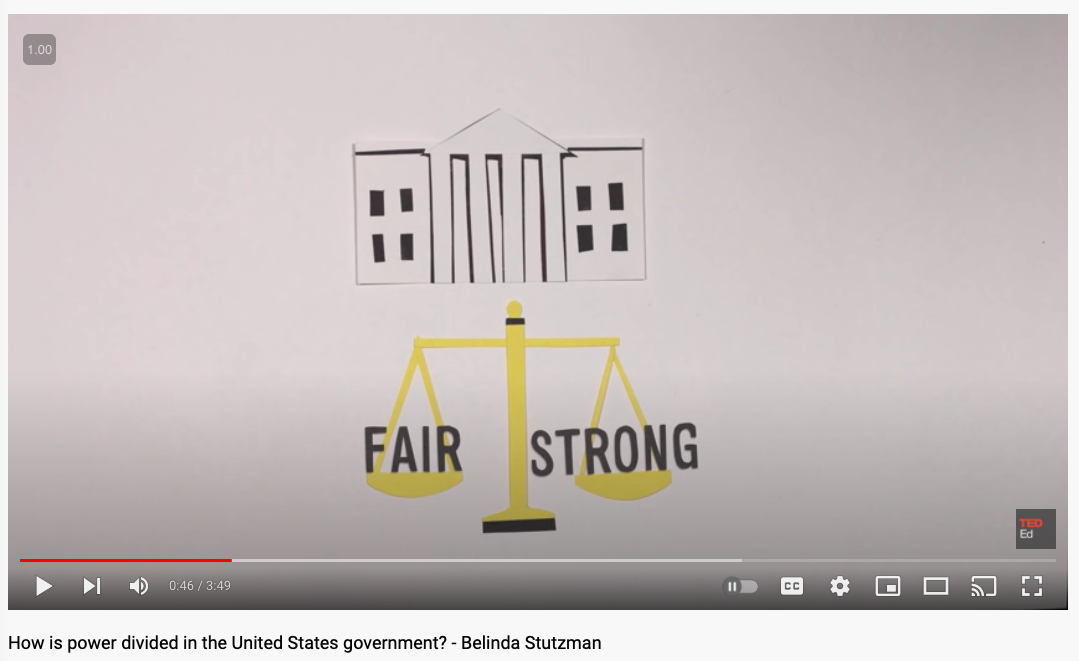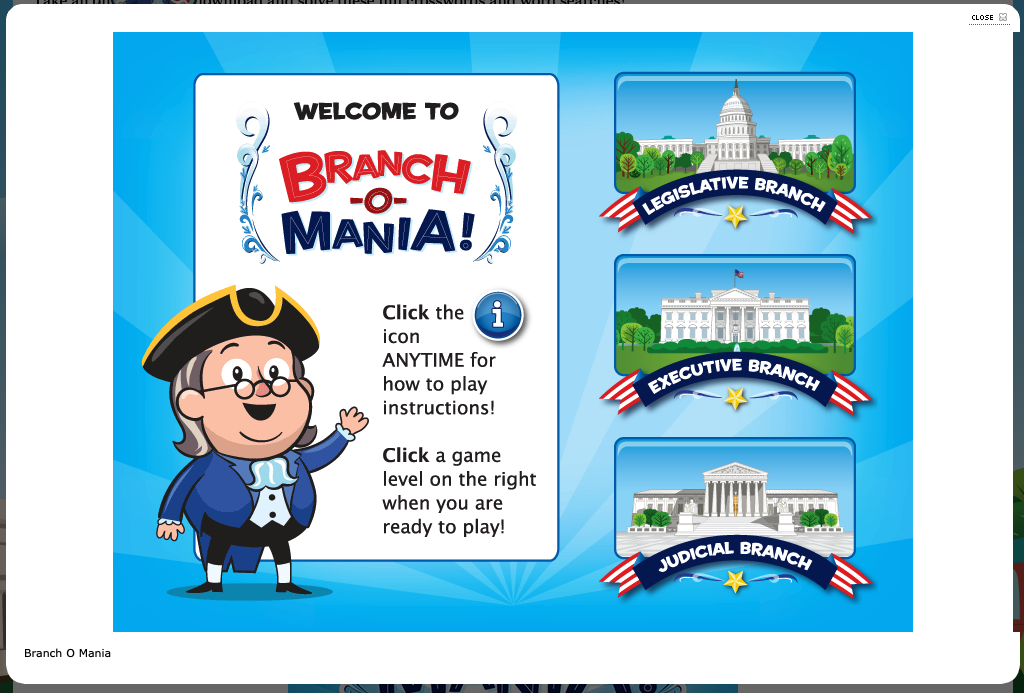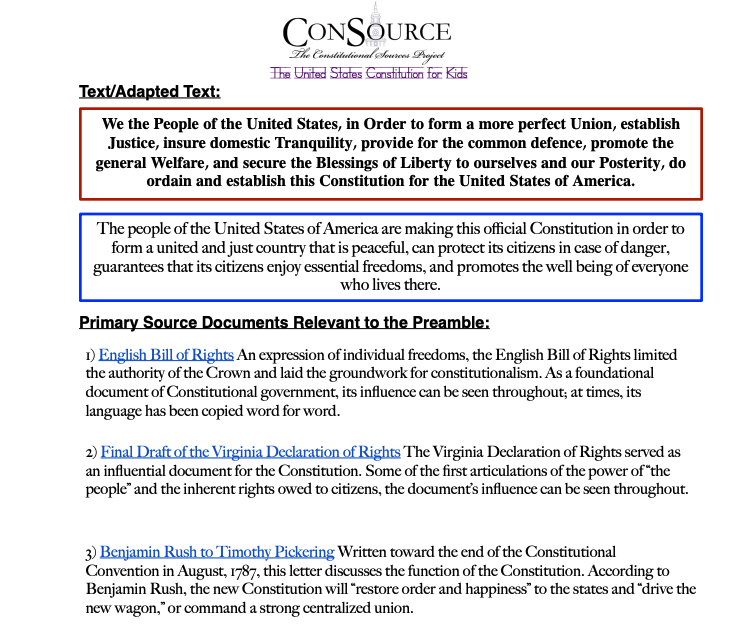← Return to American Government Main
American Government Websites and Videos for Students
Looking for American government websites and videos to share with your students? If so, this is the list for you. It is a roundup of engaging and informative websites and videos for students all about the American government.
Kids have access to see, listen to, and read about more than ever before. We can leverage that to our advantage! When we partner with students as they explore the digital realm of the world, we can provide the guidance and tools they need to learn to safely navigate it. You can read more about using websites and videos in the classroom here.
If you’re ready to dive into this list of websites and videos, you can click through the navigation below or keep scrolling. Click on the images to access the resources listed. Be sure to preview all resources to determine age-appropriateness before sharing them with your students.
Jump to:
Videos
BrainPop Jr.’s “The US Constitution: What Powers Does it Have?” Video
“The U.S. Constitution opens with the words "We the people." It's a perfect start for a document that lays out the basic rules of a democracy! At a time when most countries were ruled by kings and queens, the founders of the United States wanted a system in which everyone has to follow the law. In this BrainPOP movie, Tim and Moby talk to students all about the US Constitution: https://brnpop.co/3gmbw7N Yes, it's the supreme law of the land—but it's also a living document that can adapt to changing times while holding to its core principles. Click "play" to learn more!”
TED-Ed’s “How is power divided in the United States government?”
“Article II of the United States Constitution allows for three separate branches of government (legislative, executive, and judicial), along with a system of checks and balances should any branch get too powerful. Belinda Stutzman breaks down each branch and its constitutionally-entitled powers.”
TED-Ed’s “Why is the US Constitution so hard to amend?”
“When it was ratified in 1789, the US Constitution didn’t just institute a government by the people – it provided a way for the people to alter the Constitution itself. And yet, of the nearly 11,000 amendments proposed in the centuries since, only 27 have succeeded as of 2016. Peter Paccone explains why the US Constitution is so hard to change.”
Liberty’s Kids’ “We the People”
America’s leaders meet at a convention in Philadelphia and decide to write a radical new Constitution. Ben Franklin, in his final moment on the world stage, helps forge the “Great Compromise” on legislative representation. James Madison writes much of the Constitution, the lawful embodiment of the promise of the Revolution (9/17/87). It includes the “odious compromise” on slavery that maintains the practice’s legality in the United States. George Washington is inaugurated as the first President (4/30/1789). Moses resolves to open a school for free black children. Sarah’s father joins the family from Ohio. Everyone looks forward to their new lives in the United States of America.
TED-Ed’s “A 3-minute guide to the Bill of Rights”
Daily, Americans exercise their rights secured by the Constitution. The most widely discussed and debated part of the Constitution is known as the Bill of Rights. Belinda Stutzman provides a refresher course on exactly what the first ten amendments grant each and every American citizen.
TED-Ed’s “How to understand power”
Every day, we move and operate within systems of power that other people have constructed. But we’re often uncomfortable talking about power. Why? Eric Liu describes the six sources of power and explains how understanding them is key to being an effective citizen.
TED-Ed’s “How do executive orders work?”
On January 1, 1863, Abraham Lincoln legally changed the status of over 3 million people from “slave” to “free.” But his emancipation proclamation wasn’t a law — it was an executive order. The framers of the American Constitution made this power available to the executive branch. But what exactly is this tool, how does it work, and what’s the extent of its power? Christina Greer explains.
TED-Ed’s “How does impeachment work?”
For most jobs, it’s understood that you can be fired – whether for crime, incompetence, or just poor performance. But what if your job happens to be the most powerful position in the country – or the world? That's where impeachment comes in. But how does it work? Alex Gendler details the process of impeachment.
United States Capitol’s Video Tour of the U.S. Capitol
Join one of the U.S. Capitol Visitor Center’s guides for this video tour of the U.S. Capitol.
National Constitution Center’s Constitution Hall Pass
An award-winning video lesson series produced by the National Constitution Center.
Interactive Features & More
Mount Vernon’s “President Washington’s Inauguration” Timeline
Explore this interactive timeline, including images and videos, of “George Washington's inauguration ceremony in New York City” that “was a grand historical event, attended by hundreds.”
Ben’s Guide “Branch-o-Mania” Game
“Test your knowledge of the three branches of the U.S. Government!”
Ben’s Guide “Quizzes, Crosswords & Word Searches”
“Take an online quiz or download and solve these fun crosswords and word searches!”
Teacher Resources
The Constitutional Source Project's “ConSource: The United States Constitution for Kids”
“The ConSource U.S. Constitution for Kids offers educators and students the opportunity to read the original text of the Constitution alongside unbiased translations that are easy for students to understand. Also included is useful background information, which places each clause in historical context.”
Center for Civic Education’s Lesson Plans
You can click through each of the topics listed on the right to see a longer listing of many lesson plans and resource materials available for each topic.
The Annenberg Classroom’s Resource List
This resource list is INCREDIBLE but it is geared towards 6th grade+. If you teach in a class with advanced students needed extension or enrichment, this website may be helpful to you.
“AnnenbergClassroom.org provides a comprehensive, multimedia curriculum on the Constitution. Our free classroom resources include videos, games, lesson plans and timelines as well as our popular Annenberg Guide to the Constitution, which provides the original text and then explains it in plain language. These materials are provided to equip middle and high school teachers with the tools to create informed citizens who understand their rights and responsibilities as outlined in the Constitution. AnnenbergClassroom.org strives to help develop citizens who demand and support a functioning democracy, realizing Mrs. Annenberg’s vision of generations who will go out and fulfill their civic calling.”


















